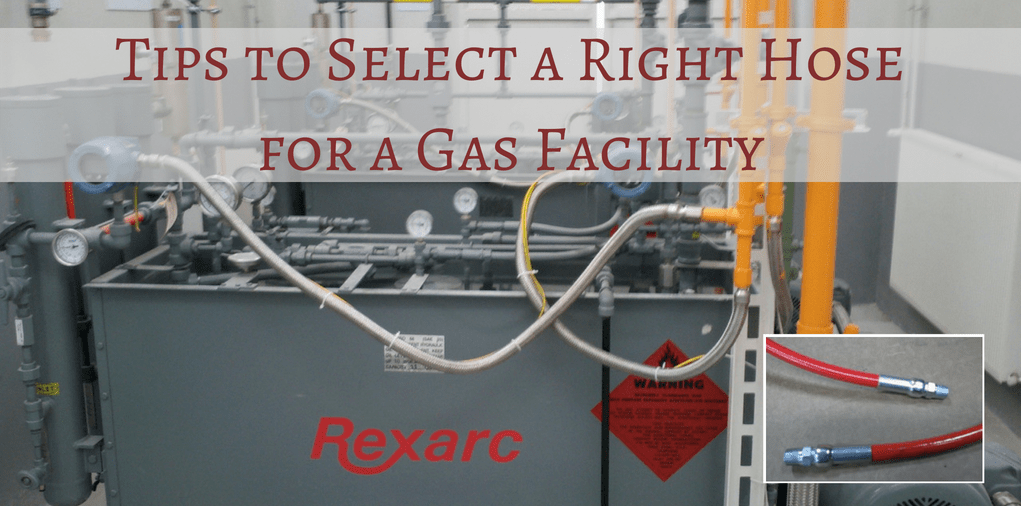Rexarc is currently open from 7:30 AM – 4:00 PM EST, Monday – Friday. Read More
Rexarc is currently open from 7:30 AM – 4:00 PM EST, Monday – Friday. Read More

Hoses get used in industrial facilities dealing with different types of gases. These are hollow and flexible tubes, which get used to pack dissolved gases such as acetylene, and atmospheric gases such as oxygen, and argon in cylinders or for conveying them as a part of a process. Facilities working with such gases must understand the potential impacts of hose failure on the people handling them. Mismatch of application and the type of hose is one of the major reasons for the hose failure. Thus, selection of the right type of hose for a typical application becomes a critical element of safety in such facilities. Yet, it is also one of the most overlooked factors. How do you select the right hose for an application? This post discusses a few important factors that play a key role while selecting the hose.
Things to Consider When Selecting a Hose for a Facility Working with Gases
The following factors will help cut the failures occurring due to the wrong selection of hoses.
1. Pressure: This is the most important consideration to make while selecting the hose for your facility. The actual working pressure of the hose should be higher than the greatest working pressure of the application.
2. Materials of Construction: This varies based on the gas used. They are currently available in the following materials:
a. All Metal Corrugated Hoses: As the name suggests, these hoses have metal corrugated inner core. The core is usually made from Monel or Stainless Steel. The metal hoses help ensure zero permeation, which makes them suitable for stationary gas applications. Corrugated metal hoses are most used with hydrogen and helium gases (4250 PSIG). Hoses with Monel inner core is often favored for corrosive gases.
b. Rigid Metal Hoses: These hoses are well-suited for stationary applications due to the limitations in bending and flexing. Rigid metal hoses are economically priced, which makes them affordable.
c. Rubber: The hoses made of rubber are ideal for applications, which need flexibility. Easy availability and economic pricing of these hoses have contributed to their popularity across various industries. However, rubber hoses are not recommended for applications, which demand high purity.
d. Ethylene tetrafluoroethylene (ETFE): These hoses are durable, flexible, and economical. ETFE hoses are not ideal for conveying oxygen.
e. Polytetrafluoroethylene (PTFE) Teflon: The hoses are widely used in the filling plants in the USA. PTFE Teflon hoses offer immense flexibility, durability, and suited for high-pressure applications up to 3000 PSIG. These hoses are often lower priced, too.
f. PTFE (Teflon) “Post Sintered”: As the name suggests, the hoses are made from post sintered Teflon. During the sintering process, the PTFE is baked again at a controlled temperature and pressure. This helps in improving its wall thickness, as well as molecular bonds, thereby reducing diffusion and effusion. These hoses are typically suitable for pressures up to 3600 PSIG.
3. Velocity and Dynamic Stress: Dynamic stresses, also referred to as impact or mechanical stresses, occur due to deceleration or acceleration of masses during the handling, transport, or storage of gases. Dynamic stress is one of the important factors of hose failure. The hoses made from metal have certain limitations on the velocity and dynamic stress. They should not be over bent or bent in more than one plan during the gas transport. Corrugated metal hoses are not suited for handling high flow rates or high velocity. Hence, it is important to understand the velocity rate of an application before making a buying decision. The values the velocity rate and flow rate for the application should be lower than the threshold recommended for a particular hose. This is because an increase in either of these factors may lead to premature cracks during the operation.
4. Permeation: This is the property of the gas to penetrate through the hose. The hoses made from metals are considered ideal for applications, where permeability can be a key concern.
5. Purity: Some hoses support both – effusion and diffusion of gases. The diffusion leads to contamination, which may affect the purity of gas. It is always ideal to use a metal hose in applications, where purity may be a major concern.
The above-mentioned are easy-to-follow, yet proven factors, which have helped filling plants and other facilities working with gas to reduce their hose failures. In addition to these considerations, it is important to source the hoses from a reliable supplier and manufacturer of gas filling plants. Rexarc International, Inc. provides reliable and high-quality safety hoses, which are widely utilized in gas filling stations.

We are a one stop shop from custom vessel production to full skidding, plumbing and instrumentation.

We stand by our processes and communicate with you on your project status as much or as little as you would like.

We continually reinvest in our people, business, and equipment technology to ship quality products on time.
